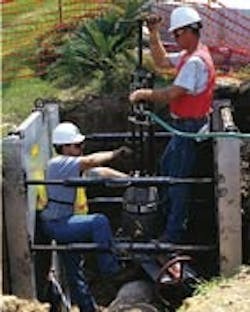Line Stopping Restores Safe Operation to Hospital's Sewer System
Disruption of water and wastewater services can be inconvenient. But sometimes, a main system shutdown can have serious consequences. In hospitals, for example, 24-hour water service is crucial to maintain human health and safety. Therefore, general maintenance and repair on water and wastewater—and even gas distribution systems—must be done without disrupting safe access to water.
In February 2003, a Petoskey, Mich., hospital faced a serious challenge to public health and safety when construction workers on a nearby project site accidentally breached the hospital’s 8-in. gravity sewer with an auger, filling it with concrete, rendering the sewer useless. Engineers and contractors tried to remove the hardened grout by jetting and rodding it out of the system. However, the 8-in. gate valve was completely filled, restricting the flow of septic waste.
In an effort to quickly solve the problem, engineers contacted Severn Trent Services, who employed Hydra-Stop products to fix the problem. Hydra-Stop equipment is designed to perform line stopping, line tapping, valve insertion and valve exercising protocol.
Quick, effective solution
Once on the scene in Michigan, it was determined that the city’s force main, which feeds the treatment plant for the entire city of Petoskey, cycled approximately every 10 minutes at peak times and every 20 minutes at off-peak hours.
With concrete filling approximately one-half of the main at the point of the 8-in. tie-in, engineers and city officials concluded that approximately 250 ft. of the 14-in. force main had to be removed and replaced, without interrupting flow to the treatment plant.
Live-taps were performed upstream and downstream of where the line stops were to be replaced, allowing waste to flow uninterrupted. Mounted line-stop fittings and specialized taps enabled the insertion of the stops. Once the stops were inserted and the waste rerouted, engineers were able to remove the damaged pipe and replace it.
Replacing the damaged piping would have taken upwards of 30 days to complete, rendering the hospital and surrounding buildings out of service. However, only four days were needed using line stopping, keeping the water running to the hospital and the city of Petoskey, avoiding a serious health problem.
Brett Hanes is vice president, Hydra-Stop Products. He can be reached by e-mail at [email protected] or by phone at 800-535-7867.
